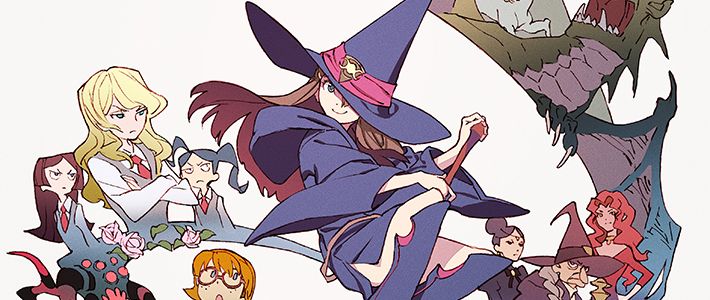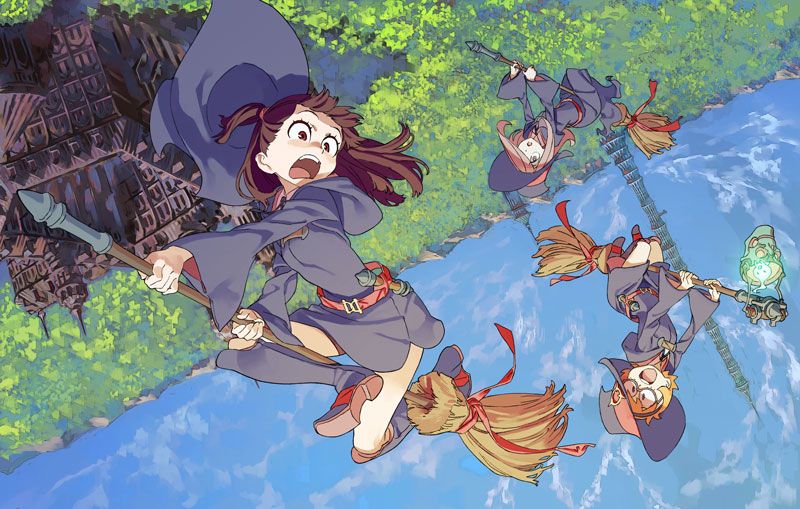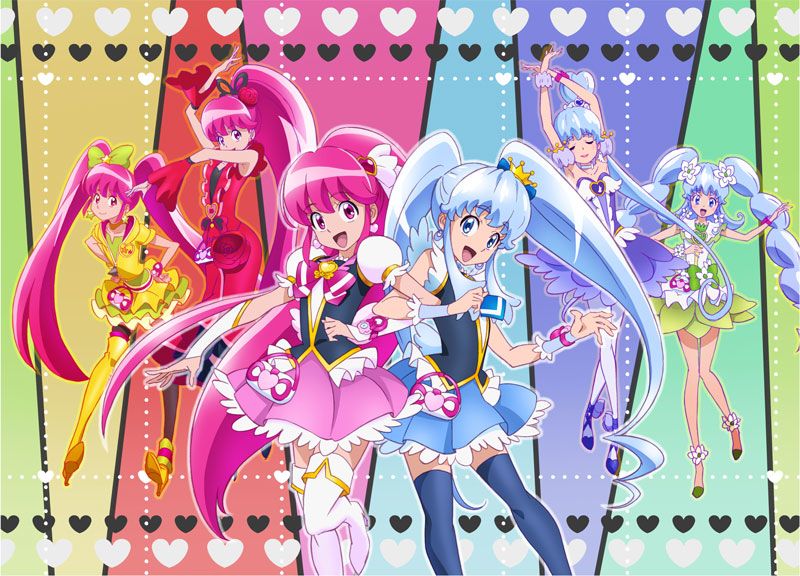
Manga and Anime as the Japan Brand
Children of Sailor Moon: The Evolution of Magical Girls in Japanese Anime
Culture- English
- 日本語
- 简体字
- 繁體字
- Français
- Español
- العربية
- Русский
She’s clumsy. She hates schoolwork. Furthermore, she’s bad at sports. In her everyday guise as a schoolgirl, she doesn’t exactly shine. But when she summons her magic, she is instantly transformed into an impossibly cute superheroine who battles dauntlessly against monsters and villains. This is the mahō shōjo, the magical girl familiar to Japanese anime fans worldwide.
Since the global success of Bishōjo senshi Sērā Mūn (Pretty Soldier Sailor Moon) in the 1990s, anime fans have come to associate mahō shōjo anime with a very specific type of heroine—a schoolgirl who transforms herself into a fetching super-warrior armed with a magical scepter or some other prop with which she courageously fights the forces of evil. But the mahō shōjo genre of anime actually goes back to the early days of Japanese television animation, and the magical girls of the 1960s were very different from today’s morphing warriors. What can the evolution of mahō shōjo in anime tell us about gender and the changing self-image of girls in Japanese society?
Two Prototypes of the Sixties
The first magical heroine in Japanese TV anime debuted in 1966 with the program Mahōtsukai Sarī (Sally the Witch). In this animated series, a little princess from the Magic Kingdom arrives in the world of humans in the guise of a girl named Yumeno Sally and creates a stir with her special powers. In addition to bringing the mahō shōjo to television, Mahōtsukai Sarī was the first Japanese animation series specifically targeting young girls.
According to Sally’s creator, the plot was inspired by the popular American sitcom Bewitched, which was dubbed into Japanese and aired on Japanese television around the same time. In the American show, Samantha—a young, pretty witch with a conventional human husband—delighted viewers by introducing the extraordinary into ordinary middle-class life. Another inspiration may have been the very special British nanny who drops down from the sky and magically disposes of household chores in the movie Mary Poppins (1964), released in Japan in 1965. In any case, it is clear that Japanese anime’s first mahō shōjo was conceived as a sorceress in the Western mold.
Like Bewitched, Sally the Witch was an episodic comedy show, and like Samantha, Sally adhered to the Western image—rooted in Christian tradition—of the witch or sorceress who uses spells to perform magic. But as a visitor from another world, Sally also stood as a potent metaphor for Japan’s westernization and modernization in the rapid-growth era. Bringing novelty and transformation to the world of humans (Japan) from her remote and magical realm (the West), she gradually assimilated with her new home as she interacted with her human friends.
Another pioneering mahō shōjo anime of the 1960s was Himitsu no Akko-chan (The Secret of Akkochan; 1969–70), about an ordinary girl who is granted magical powers in reward for a good deed. The heroine of the story, Kagami Atsuko, or Akko-chan, shows such respect and care for a broken mirror that the “mirror spirit” rewards her with the gift of a magical compact that allows her to transform into anything or anyone she chooses. With the appearance of Akko-chan, the world of anime had established its two basic mahō shōjo prototypes: the Sally type, a conventional witch who brings novelty and transformation to the world of human beings; and the Akko type, an ordinary girl who suddenly finds herself in privileged possession of magical powers.
Little Witches of the Seventies
The 1970s saw the birth of two immensely popular Sally-type magical heroines. One was Mahōtsukai Chappī (Chappie the Witch; 1972), and the other was Majokko Megu-chan (Megu, the Little Witch; 1974–75), which brought the term majokko (little witch, or girl witch) into use as a general term for magical-girl protagonists. In the latter series, Megu, a contender to the throne of her magic kingdom, has been sent to live among humans as a kind of rite of passage—as has her rival, Non. Both find a place in homes with grown-up witches who are married to human beings.
Set in what looks like a Western city, Megu is distinguished by the use of multiple heroines (in the form of rivals), the absence of identifiable nationalities or ethnicities, and a new quality of lighthearted, girlish sexuality. In addition, the series broke new ground with its focus on the relationship between the witches Megu and Non, two very different personality types, as they clash, occasionally come together, and gradually forge a friendship. Until that time, the only TV programs highlighting the friendship between young girls were anime and live-action dramas in the sports genre (although portrayals of boys’ friendships and rivalries were common).
Against the backdrop of the women’s liberation movement, the mahō shōjo anime of 1970s introduced a certain coquettishness into the persona of the magical girl. This was not about attracting men through sex appeal, but was portrayed to girls as part of female empowerment. This majokko genre of the 1970s was dominated by the productions of Tōei Animation studio.
Morphing into “Women” in the Eighties
In the 1980s, studios other than Tōei began producing new anime titles in the mahō shōjo genre. Two in particular gained a significant following among male viewers as well as girls: Mahō no purinsesu Minkīmomo (Fairy Princess Minky Momo; 1982) and Mahō no tenshi Kurīmī Mami (Magical Angel Creamy Mami; 1983–84). Minky Momo features a Sally-type “little witch,” while Creamy Mami is about an ordinary girl who obtains magical powers, in the Akko tradition. What both heroines have in common is the magic ability to morph into a grown-up image of themselves.
The protagonist of Minky Momo, 12-year-old Momo, is a fairy princess from the magical world of Fenalinasa whose mission on earth is to restore people’s hopes and dreams. When she encounters a problem that she is unable to solve as a child, she uses her magical powers to transforms herself into a young woman. In the story, she ultimately loses her powers and is killed in an automobile accident. But not to worry: It turns out that the whole adventure was a dream from which Momo awakens to resume life as human being, having learned important lessons along the way.
Yū, the nine-year-old heroine of Creamy Mami, is granted similar powers, but only for a period of one year. Yū transforms herself into a beautiful young woman, but complications ensue when a talent scout discovers her and arranges her debut as a pop star. Yū then finds herself in a bizarre love triangle with her older persona as a rival when her friend and heartthrob Toshio falls for the teen idol Creamy Mami. For the next year, Yū lives a double life, juggling stardom with elementary school while expressing herself in her role as a pop idol. In the end she loses her magic and embraces her real self.
Young girls often fantasize about being glamorous women in the adult world, but being permanently trapped in adulthood would be scary. In the mahō shōjo anime of the 1980s, magic offers the heroines a means of self-expression and self-affirmation by allowing them to experience adulthood temporarily.
In Japan, the 1980s were a time when women began to come into their own. This was the decade that saw the rise of women politicians, including Doi Takako, who was to become the first female leader of a Japanese political party. In pop culture, it was the heyday of such female superstars as Matsuda Seiko and Princess Princess. With the enactment of the Equal Employment Opportunity Act in 1985, the future seemed bright for Japanese women. The mahō shōjo of this period use magic to bridge the gap between their real selves and their ideal of young womanhood and start coming to grips with social norms of feminine beauty and sexuality.
Rise of Girl Power in the Nineties
In the 1990s, Sailor Moon (1992–97) took the world by storm and spawned a global craze for an entirely new breed of mahō shōjo: the magical girl as henshin (transforming) warrior. The Sailor Moon type is a seemingly ordinary schoolgirl who changes into an adorable costume, equipped with really cute accessories, and releases her magic energy with the help of a scepter (or similar weapon) to do battle against the forces of evil. Drawing on the “henshin hero” format of such popular special-effects (tokusatsu) live-action shows as Tōei’s Uchū keiji (Space Cop) and Super sentai series (adapted as the Power Rangers for the US market), Sailor Moon brings together various old and new idioms of the mahō shōjo genre. The heroine, Tsukino Usagi, starts out as an ordinary middle-school student and then acquires the power to transform herself (in the Akko mold); later, however, we learn that she is actually the incarnation of a princess from an ancient kingdom on the moon (Sally type). She assembles a team of five mahō shōjo (multiple heroines), who undergo a dress-up metamorphosis before engaging in supernatural battles. The series also introduces mothering as a recurring theme.
Sailor Moon is an iconic product of the 1990s, the era of “girl power” in the West, when girl bands were singing songs of feminine toughness and self-reliance. The magical girl warriors of Sailor Moon were Japan’s symbols of girl power, joining together to battle evil on their own, without the benefit of male leadership. (Although the cast of characters includes a male hero, Tuxedo Mask, his supporting role recedes as times goes on.)
A key attribute of the Sailor soldiers is the nature of their transformation. In their sailor collars and miniskirts, with their long hair, manicured nails, and smart accessories, they look singularly ill equipped to do battle. When male superheroes like Kamen (Masked) Rider and the Super Sentai teams morphed, the changes were clearly designed to make the heroes stronger. But the transformation of the Sailor girls functioned primarily to exaggerate their feminine good looks and sexuality. In a major paradigm shift, Sailor Moon represented power using standard attributes of youthful feminine beauty and sexuality, negating the traditional dichotomy between cuteness and strength.
But Sailor Moon also highlights some of the softer emotions and impulses traditionally associated with femininity. Most notably, it focuses on the maturation of a heterosexual love relationship between Usagi and Chiba Mamoru and features maternal, nurturing behavior toward the young juvenile characters Chibiusa and Chibichibi Moon. As we shall see, this is one of the characteristics that distinguish the mahō shōjo of the Sailor Moon mode from typical Western superheroines.
Diversification After 2000
 Little Witch Academia depicts the adventures of Akko and her friends at a European school for witches. A limited YouTube release with English subtitles attracted international fans, leading to a Kickstarter-funded sequel, which is set for a cinematic release. © Y.YOSHINARI/TRIGGER.
Little Witch Academia depicts the adventures of Akko and her friends at a European school for witches. A limited YouTube release with English subtitles attracted international fans, leading to a Kickstarter-funded sequel, which is set for a cinematic release. © Y.YOSHINARI/TRIGGER.
Sailor Moon provided the template and vocabulary for countless imitations and parodies in the “henshin warrior mahō shōjo” mode. A battalion of girls in their second year of middle school continues to fight evil in the Purikyua (Pretty Cure) franchise, launched in 2004. Late-night anime targeting older viewers, including Mahō shōjo Ririkaru Nanoha (Magical Girl Lyrical Nanoha; 2004–7), Mahō shōjo Madoka Magika (Puella Magi Madoka Magica; 2011), Gen’ei o kakeru taiyō (Day Break Illusion; 2013), and Fate/kaleid liner Purizuma Iriya (Fate/Kaleid Liner Prisma Illya; 2013) have expanded the expressive range of the genre by exploring darker and more mature themes, including death, absurdity, and the price of magical power.
Other notable productions of the twenty-first century fall into the traditional “little witch” lineage. These include Mahō shōjo-tai Arusu (The Adventures of Tweeny Witches; 2003–4) and Little Witch Academia, a global Internet hit that originated in Anime Mirai 2013 (a showcase for young animators). In these anime, the heroines are human girls who are learning to be witches. Although outsiders, they end up bringing about change by demonstrating the importance of hopes and dreams.
Japan’s Nurturing Witches
This brief historical survey reveals a huge range in the mission of the mahō shōjo, from solving everyday problems to saving the world. However, the underlying plot is remarkably consistent throughout: schoolgirls growing and maturing through their use of magic powers.
Comparable girl superheroes are by no means absent in the West. Since the late 1990s, live-action dramas like Sabrina the Teenage Witch (in the Sally mold) and Buffy the Vampire Slayer (in the magical warrior mode) have gained a big following in the United States, and the animated TV series W.I.T.C.H. (clearly influenced by Sailor Moon) was popular in Europe. Before that, however, girls with supernatural powers were commonly in the grip of dark forces, often associated with the threatening changes of puberty (as in films like The Exorcist and Carrie).
Female superheroes, meanwhile, were almost invariably adults. The heroines of such comic-based TV shows as Wonder Woman and Xena: Warrior Princess and the video game–based movie Lara Croft, Tomb Raider were endowed with male strength but also a mature sex appeal targeted primarily at heterosexual men.
An attribute virtually nonexistent in Western witches or female superheroes is the maternal or nurturing behavior that has become such a common feature of mahō shōjo anime since the advent of Sailor Moon. While powerful, Japan’s magical girl warriors also preserve attributes associated with traditional gender roles—including cuteness and maternal affection—that make them less threatening to men.
As the foregoing survey suggests, the mahō shōjo of Japanese anime originated in a character inspired by the witch of Western tradition and gradually acquired a unique combination of attributes to emerge as a feminine icon very different from its Western prototypes: a powerful yet cute and nurturing superheroine. Since the 1990s and the advent of Sailor Moon, the “reimportation” of this Japanized girl-witch has in turn inspired a new style of superheroine in Western popular culture.
Nostalgia and Rebellion
Where are mahō shōjo anime headed next?
Some of them seem to be turning back toward the fairy princesses of an earlier era. The heroines of Happiness Charge Pretty Cure, for example, combine the “girl power” and appeal of Sailor soldiers with the traits of the nostalgic princess archetype.
 Happiness Charge Pretty Cure, the eleventh Pretty Cure series, started airing in 2014 to celebrate the tenth anniversary of the franchise. The twelfth series, Go! Princess Pretty Cure, is currently airing. © ABC/ Tōei Animation.
Happiness Charge Pretty Cure, the eleventh Pretty Cure series, started airing in 2014 to celebrate the tenth anniversary of the franchise. The twelfth series, Go! Princess Pretty Cure, is currently airing. © ABC/ Tōei Animation.
At the other end of the spectrum we see a trend toward rebellion against sexual norms. An example is the rejection of heterosexual love in favor of yuri, love between women, as seen in Puella Magi Madoka Magica. The recent appearance of an anime series about boys who turn into magical girls can be seen as another indicator of this trend, notwithstanding the comic’s tongue-in-cheek tone.
But whatever developments the future may hold, the mahō shōjo genre will doubtless endure and remain an inexhaustible fund of material for the study of gender and the identity struggles of girls in Japanese society.
(Originally published in Japanese on February 17, 2015. Banner photo: Little Witch Academia. © Y. Yoshinari/Trigger.)